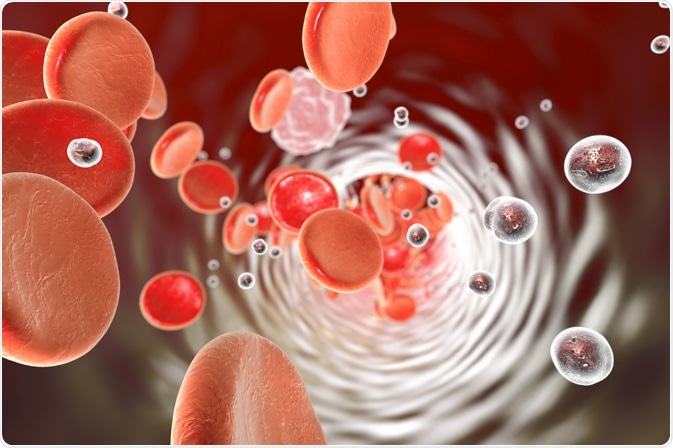Nanoelectronic biosensors are nanostructured semiconducting materials that facilitate appropriate solutions for biological activities at the cellular level. Current research in the field of medicine and nanotechnology has allowed for the formulation of bioengineered mechanisms to improve medical diagnosis and treatment, thus enlarging the scope of diagnosis at the cellular level.

Image Credit: Kateryna Kon / Shutterstock.com
The need for nanoelectronic biosensors
While the course of medicine, especially during treatment and diagnosis, continues to improve and target more specific diagnostic and treatment methodologies, the route of diagnosis using common forms of medical technologies such as magnetic resonance imaging (MRI), electromagnetic radiation, computed tomography (CT) scans, and ultrasounds continues to pose challenges in terms of detail and accuracy.
Because treatment plans and diagnoses are important factors in the prognosis of the disease, it is essential for the field of medicine to develop innovative strategies to target areas and issues which these common methods are not able to address. This need paved the way for the development of nanoelectronics.
Nanoelectronic biosensors are part of a collective term of nanotechnology called nanotherapeutic solutions. These electronic solutions are developed by a collaboration of highly integrated multidisciplinary teams comprised of mechanical and electrical engineers, physicians, scientists, bioengineers, biochemists, and physicists.
Over the years, the appropriate formulation and strategies have been developed to ensure the efficient roll-out and long-term effectivity of biosensing mechanisms. Nowadays, nanoelectronic biosensors are utilized in the treatment and diagnosis of various human medical conditions, including cancer, cardiovascular diseases, and brain diseases.
Nature-Inspired Nanophotonics: Butterfly Eureka! Moments | Robert Magnusson | TEDxUTA
Utilization of material alternatives
Nanoelectronic biosensors are typically made up of nanowires with high conductivity. The production of these biosensors is done to ensure that the sensors, which will be inside the body, are efficiently able to send electrical signals to a remote device that would be used by the physician to monitor and determine the cellular activity.
Recent studies have explored the utilization of material alternatives to facilitate better performance than the typical nanoelectronic biosensors.
Researchers realized that because of nanosensors’ simple and efficient design, it is also possible to use different wires, such as a silicon nanowire. This type of wire is a single-walled carbon nanotube that expands the potential of nanoelectronic biosensors by enabling faster recognition of biosensing targets.
Graphene-based nanoelectronic biosensors are also utilized as a primary alternative. Graphene, for example, is a carbon allotrope that has excellent electrical and electronic properties which would allow for higher carrier capacity and mobility, highly tunable conductance, and good ambipolar field effect. Because graphene also has a large surface-to-volume ratio, its use in nanoelectronics has been promising.
In tests measuring the effectivity of graphene in nanoelectronics, it was found that large-sized chemical vapor deposition (CVD)-grown graphene films were able to facilitate real-time molecular biosensing. In other studies, it was found that graphene biosensors could also be used in detecting chemical and biological processes at a cellular level. This would mean that nanoelectronic biosensors made with graphene could be utilized under many different physiological conditions.
In some cases, the typical nanoelectronic sensors which are based on charge detection are also sought to be improved by their administration with a molecular dipole detection that is facilitated by graphene sensors.
References
- Chen, P. (2012). Interfacing Biology with Nanoelectronics. Journal of Biosensors & Bioelectronics, 3(2), 1000e105.
- Cooke, J. P., & Atkins, J. (2016). Nanotherapeutic Solutions for Cardiovascular Disease. Methodist DeBakey Cardiovascular Journal, 12(3), 132–133.
- Gao et al. (2016). Specific detection of biomolecules in physiology. Proceedings of the National Academy of Sciences of the United States of America, 113(51), 14633-14638.
- Huang et al. (2010). Nanoelectronic biosensors based on CVD grown graphene. Nanoscale, 2(8), 1485-8.
- Kulkarni, G.S., Reddy, K., Zhong, Z., & Fan, X. (2014). Graphene nanoelectronic heterodyne sensor for rapid and sensitive vapour detection. Nature Communications, 5.
- Nanoelectronic biosensors. (2015). Retrieved from http://www.clinicalnanotech.com/nanoelectronic-biosensors.html.
- Park, C.S., Yoon, H., & Keon, O.S. (2016). Graphene-based nanoelectronic biosensors. Journal of Industrial and Engineering Chemistry, 38, 13-22.
Further Reading
Last Updated: Apr 26, 2021